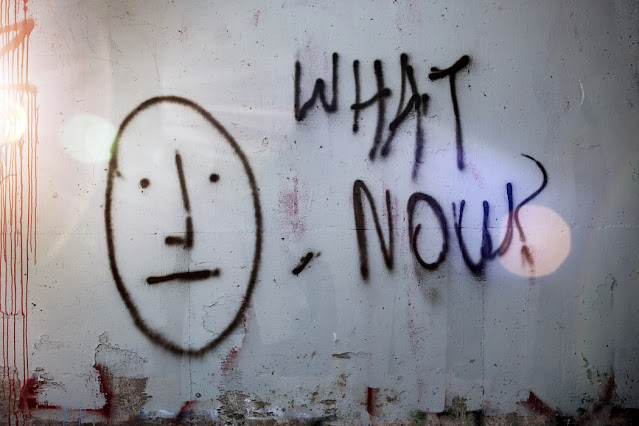Persisting with the Possible
Mark 16: 1-8
New Ark United Church of Christ, Newark, DE
April 4, 2021
The Easter story as told by the gospel of Mark is my favorite telling of it. Not because I particularly like it, but because of its unfinished, abrupt ending and the completely human reaction of Mary Magdalene and the other women. I appreciate this story because it is such a vivid description of how we move from faith experience to ministry, from truth to change, from endings to beginnings, or sometimes, how we don’t at first.
Mark’s gospel was written around 70 CE, right as Rome was sacking Jerusalem, destroying the temple and whatever homegrown community had been created by those who followed Jesus. The words “he is not here” were never more true and now even more painful. What could they say that anyone would believe? Who would listen to the testimony of women, even those who were closest to Jesus?
What I think is most frightening about this story in that I-don’t-know-if-I-can-do-this kinda way is that the same life-giving, love-inducing power by which Jesus healed broken lives and hearts is the same power that raised Jesus from the grave is also a power that abides in us and works through our imperfect human lives. What is the transformation that Jesus offers if not new life? What is it we offer as the Body of Christ if not a transformed community that then is about the liberation of others?
We can be terrified of change, even the good stuff, even the things that lead to healing, wholeness, and abundant life for all. Ending what is familiar, even though the familiar might be difficult or painful, can be disorienting, shattering our identity, questioning our values, shaking up what we thought we knew. Though we wish we could pick and choose what ends, what remains, what begins, often the only thing we can choose is how we will respond to the changes around us and within us. We grieve, we shake our fists, we freeze, we run away, we make one small move in a new direction. And there are times that is an awesome, sometimes overwhelming and painful task.
And yet there are things that need to come to an end in which we do have a say:
Racism. Sexism. Patriarchy. Whiteness. Transphobia. Abuse of power. Empire. Militarism. Poverty. Greed. Hate. Violence. Cruelty. Injustice. Apathy. Resentment. Self-hate and shame. Regret. Distrust. Fear of others who are different from us. “This is the way we’ve always done it”. Childishness.
Fr. Richard Rohr wrote, “Yearning for a new way will not produce it. Only ending the old way can do that.” Reforming what is wrong won’t do it. There is death before there is resurrection. And yet as we confessed earlier, despite what we sing, death stings mightily. Yes, the death, the loss of those we love stings; the price we pay for having loved so deeply. But the death of that which needs to die will also sting because in some way we benefit from all of that. There is no other way to explain our comfort with the status quo. And so it seems that when we have exhausted every other option, it will become so uncomfortable, it will sting so much, that we then might become willing to see what else is possible. Frederick Buechner wrote that resurrection means that the worst thing is not the last thing. Your story, my story, our story, God’s story is not over yet.
So today I am not quite yet in the place of resurrection joy but of resurrection hope, which is a kind of strange joy. Because it was in the midst of empire, in the midst of the domination system, in the midst of things that needed ending but still have not ended, that resurrection became a force to be reckoned with. In the midst of oppression and destruction, resurrection created life-affirming community. In the midst of violence and brutality, resurrection became a power, a hope that evil could not crush. In the midst of all that was and is wrong with the world, Jesus lavished mercy and forgiveness and compassion indiscriminately. You don’t have to prove you need it or that you are worthy of it. There is no application form, no proof of ID or your citizenship or membership in the kindom of heaven.
The Easter message that Mary eventually gave was only five words long: I have seen the Lord. Mary witnessed to what she thought was not possible. As my friend Hilary Livingston said earlier this morning, only one thing was scarier than the death of Jesus was that he was alive again. And so first that powerful truth had to get over the lump in her throat, the fear in her heart, the grief in her soul, which is a journey we all make again and again. The resurrection is an invitation to live in our discomfort zone, to persist with what is possible, with what we think is not possible.
Happy Easter, happy Resurrection Day, Church! Amen.
Even in a world aching with loss,
and crying out for repair,
the joy of Christ alive is our steady companion.
The same Spirit that has sustained hope through the centuries
promises to see us through these days.
That we might hang on to beauty,
fight for justice,
and celebrate the gifts of loving and being loved,
we go proclaiming our hallelujahs.
Our Christ is risen.
Our hope is eternal.






Comments
Post a Comment